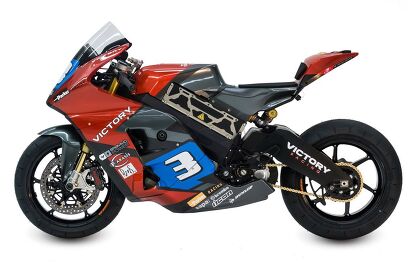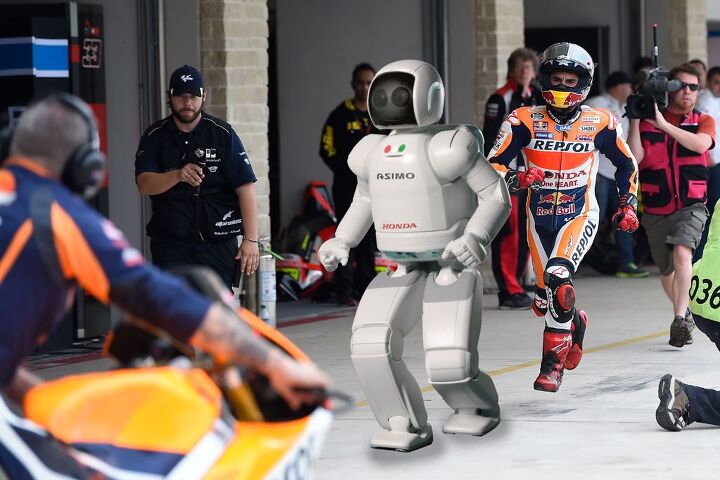Tomfoolery - Electric Faster Than Petrol at IOM TT
Andrew Capone, in his Top 5 Storylines For The 2015 Isle Of Man TT article, poses two significant topics: 1) How far are we from ‘Peak Speed?’ and 2) Will electric racing motorcycles finally capture our fancy?
Capone postulates about Peak Speed that “the limitations of the human being astride the machine must be also considered.” I would argue that this is the only consideration in substantially lowering lap times of the TT course, or any race track for that matter. Tires will continue to get stickier, engines more powerful and weights will decrease, but human physical and mental limitations will, at some point, be unable to keep up with the progress of technology. Think of it this way, in a hypothetical situation of unlimited resources, if Honda put all its might into developing an autonomous MotoGP bike, would it be able to lap a track faster than Marc Marquez? I believe it would. It might take a lot of R&D effort, but eventually it’ll happen.
If we look at the rate of lap-record advancement at the TT, however, we’re in no immediate danger of replacing human riders with robots.
| 1957: First 100-mph lap by Bob McIntyre10 mph gain in 19 yearsAverage annual increase of 0.52 mph |
| 1980: Joey Dunlop raises course record to 115 mph15 mph gain in 23 yearsAverage annual increase of 0.65 mph |
| 2000: David Jeffries sets a new lap record 125 mph10 mph gain in 20 yearsAverage annual increase of 0.50 mph |
| 2007: John McGuinness records a new lap record 130 mph5 mph gain in 7 yearsAverage annual increase of 0.71 mph |
| 2014: Bruce Anstey sets a new lap record of 132 mph2 mph gain in 7 yearsAverage annual increase of 0.28 mph |
In the early days of the TT, new lap records were being set in leaps and bounds. Take for example Jimmy Simpson, who in 1924 recorded the first 60-mph lap of the TT course. Two years later, in 1926, he added 10 mph to the lap record by setting the first 70-mph lap time. That’s an average annual increase of 5 mph. Fast forward 12 years to 1938 and Harold Daniel breaks the 90-mph lap barrier, but the average annual increase drops significantly to 1.7 mph. From here out the rate of lap-record advancement is incremental.
In 2010, the inaugural year of TT Zero, Mark Miller, aboard the MotoCzysz E1pc, recorded the first electric-powered lap record of 96.8 mph. Last year John McGuinness set a new electric bike lap record of 117.3 mph aboard the Team Mugen machine. That’s a 20.5 mph gain in four years, and an annual increase of 5.1 mph. A very similar annual increase to Simpson’s accomplishment 88 years ago, but his was a 10-mph gain in two years. In 1938 Daniel raised the lap record by 20 mph, but it took 12 years to accomplish the feat, McGuinness and Mugen went 20 mph faster in only four.
When you compare the rate at which new lap records are being set and the increase in the top speed of those lap records, electric bikes are developing much faster than their petrol counterparts. It’ll be interesting to see what the new kid, Victory, brings to the table this year as well as reigning champ Mugen. We’re well aware of the exponential rate at which modern technology is evolving, but even if electric bike lap records fall to an average annual increase of 1.5 mph, and ICE bikes continue at an average annual increase of 0.5, it’ll take about 14 years for electric bikes to be circulating the Mountain Course faster than gas bikes. I’ll wager it happens much sooner.
Granted TT Zero is currently limited to only a single lap of the Mountain compared to three for the dino-bikes (six for the Senior TT), but I’ll save the issue of endurance for a future electric Iron Butt editorial.
A former Motorcycle.com staffer who has gone on to greener pastures, Tom Roderick still can't get the motorcycle bug out of his system. And honestly, we still miss having him around. Tom is now a regular freelance writer and tester for Motorcycle.com when his schedule allows, and his experience, riding ability, writing talent, and quick wit are still a joy to have – even if we don't get to experience it as much as we used to.
More by Tom Roderick




































Comments
Join the conversation
The problem of the electric bike resides in the ... electric. Any comparison with petrol bike development is pointless. The electric bike leverages all the advances in chassis, rubber, braking that the petrol bikes have brought. Find a battery that weighs very little and has enormous storage capacity and you have beaten the petrol bikes. Hence, the future development of the electric bike will more likely follow the development of batteries/accumulators/capacitors and their electronic management, not the development of the petrol bike. Thus, the speed gains cited in the "analysis" are irrelevant.
I watched the program about the IOM electric tt, and they mentioned that it takes a $15,000 battery pack to hold as much energy as $8 worth of gasoline. Don't think I'm an electric hater, we have a hybrid car, but it will take another quantum step in battery technology before the electric bikes, or cars, will ever compete with gas burners.